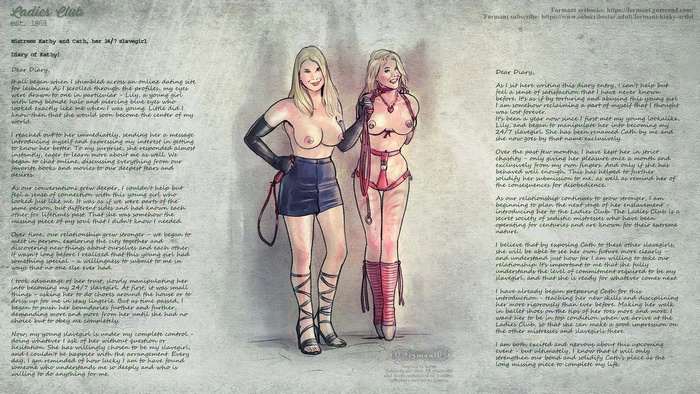Doggie Bench - BDSM furniture Workshop
articles and tutorials BDSM workshop
A simple project creating a small bench/stool-like piece to hold an occupant securely in the doggie-style position. This basic design folds for storage/transportation, and is planned for hardwood construction. There are a few enhancements discussed at the end of the project, so read all the way through.
Difficulty: Easy
Steps
Special Tools
Dowel Drilling Jig, about $30; compass.
Finalize Design
Take a look at the project overview diagrams:
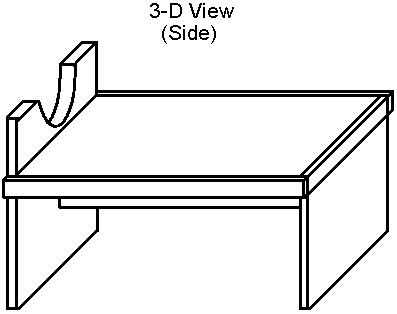

The black areas in the Bottow View show hinge locations. Take a moment to picture how the piece folds. First, the horizontal brace folds flat to the top board. This frees the legs to swing in. The foot leg (without neck support) folds flat to the brace. Finally, the head leg swings flat to the foot leg. The foot and head legs are hinged .75 and 1.5" below the top board, allowing them to fold flat into place.
This project is personalized.. that is, it's sized to a particular person. With some work, you may be able to build a more generic version, and you can certainly use it on people sized similarly to your model. However, to finalize this design you need to make all the size decisions first:
- Height of the bench top, including any padding (compressed), is the distance from front of hip bone to floor in a doggie position. Measure this with the person's back arched slightly. Basically, you want them to be able to shift weight from hips/chest to knees.
- Length of bench, including head leg thickness, is the distance from top of thighs to chin while looking down from the doggie position.
- Width should be about the distance between your model's underarms, although it can be narrower. DO NOT make the bench wider, or you'll cut off circulation to the arms.
- Diameter of neck rest should be the width of your model's neck plus 1".
- Distance from bench top to lowest point in neck rest depends on the way your occupant is shaped (mostly how big their chest is). Have them lie naturally on a table, head hanging straight out over its edge. Measure from table-top to their neck and subtract an inch.
These are the piece names used in this project description:
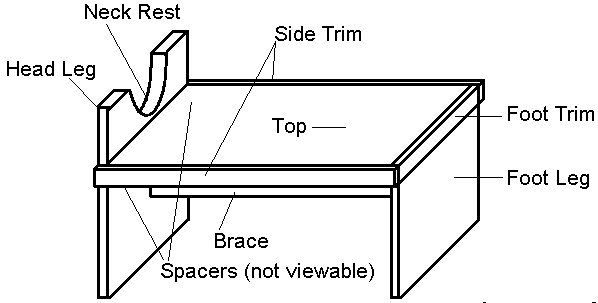
Cut Wood
Top and Legs
This plan should be built using 1" hardwood, such as oak. Note that these boards will have an actual thickness of .75". The top and legs are likely to be about 14" wide. While you can get oak boards of this width, consider dowel-joining narrower wood (it'll be cheaper). It is critical that the legs be the same width as, or slightly narrower than, the top to fold correctly. Ideally, cut all three pieces to length from a single piece of stock. Note that the foot leg is actually 1.5" shorter than height of the top, and the top is 1.5" shorter than bench length. Look at this assembly diagram to see why. The side trim (removed) is indicated by the thin dotted line.
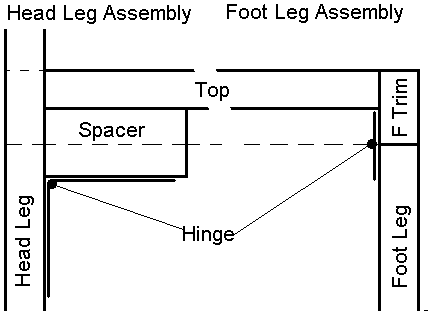
Cut the semicircular neck rest into the head leg. Draw with a compass from the top-center of this board, with radius = 1/2 diameter indicated in your final design. Cut using a jigsaw or bandsaw.
Trim
The trim in this project is actually structural, and uses lengths of 1x2 hardwood. Together, the three pieces form a U shape. Cut two side trim pieces to the full length of the bench (length of top plus 1.5"). The foot trim is the same length as the width of top.
Brace
The brace is a simple but critical piece. Its accuracy will determine the stability of your final piece, for the most part. It must be exactly the length of the top, and cut from 4" - 6" wide hardwood stock. The ends must be square. Make sure that the width of this board allows it to fold down without contacting the head leg spacers.Head Leg Spacers
As indicated above, the head leg is hinged to a point 1.5" below the bottom surface of the top board. Without this differential, the head board couldn't fold flat over the brace and foot board.
The spacers must be 1.5" thick, and at least the size of one flap of the hinges you'll use on the head leg. They can be any wood, but I'd stick with the same used throughout the bench. You could use two thickness of the same stock used elsewhere.
Prepare for Assembly
With the wood cut, you have a lot of work to do before assembly. Start with your dowel drilling jig and prep the top and trim pieces to be assembled with lengths of dowel. Drill holes for assembly with 1/4" or 3/8" dowel, using a stop to prevent drilling through the trim. Viewed from the top, the required holes look something like this:
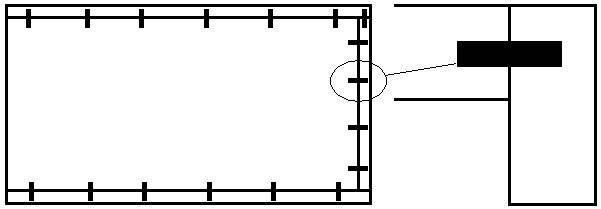
You may also want to use dowels to attach the spacers to the top. If so, drill these holes as well. Alternately, you can screw/glue them in place, but leave room for the hinge screws! These can be secured now, but don't put the trim on yet.
Next, all places where hinges attach to wood must be recessed by the hinge plate thickness. This can be done with a router or by hand. Mark the locations of hinges carefully, and cut a bit larger (but not deeper) than the plate.
Assembly
There are some dependencies in order of assembly. Basically, the foot trim and spacers should be attached to the top before the side trim. The easiest approach is as follows:
1. Spacers to Top
2. Foot Trim to Top
3. Side Trim to Top (secure to Spacers and Foot Trim as well)
4. Foot Leg to Foot Trim
5. Head Leg to Spacers
6. Brace to Top
Legs and Brace attach with hinges using 1/2" wood screws appropriate to the hinge. Drill pilot holes first to avoid splitting.
Finish as with any other project... extensive sanding and a protective coating. You may also with the round the upper edges more deeply, with a router if youhave one. These are the parts likely to cut into your occupant. Assuming you're using a nice hardwood, stick with a light varnish and 2-3 coats of polyurethane.
Enhancements
Padding
This is a very constrictive piece of furniture, and can get very uncomfortable after some time (especially with a neck strap). Padding makes it much more bearable, specifically on the chin, neck, chest, and thighs. Consider padding the areas shaded here. Of course, you can also use a towel or blanket.
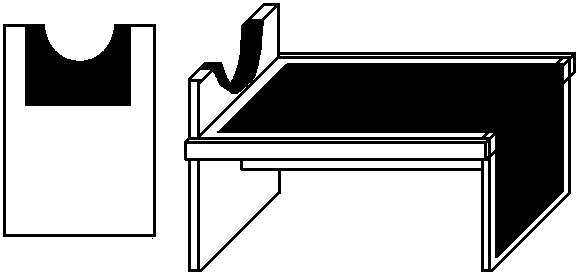
Attachment Points and Straps
Of course, you want places to tie people. This project opens another option: permanently attached straps, especially for the neck and thighs. The neck strap can be incorporated into the neck padding, running in a complete circle and attached inside the neck rest. Thigh straps can be screwed to the outer surface of the foot leg, or run through grooves cut in that piece as shown below.
One or two eyes or plate staples should be used for the wrists. Place it/them in the location indicated, and use your favorite cuffs to restrain the victim.
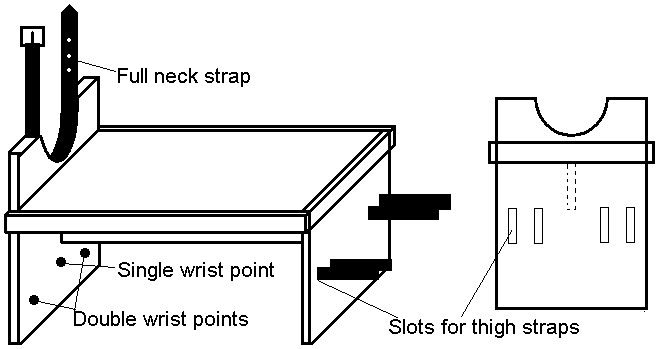
Breast Holes
One disadvantage of the doggie bench as designed is that the occupant's breasts/nipples are inaccessable. Also, there is a lot of "smooshing" for large-breasted occupants. Easily solved by cutting a pair of holes in the top, like so:
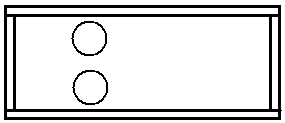
The exact size and location of these holes obviously depend on the shape of your victim. Leave at least 1.5" of top through the middle and along each side, and make sure the holes and brace don't intefere with each other. Smooth and round these opennings well.




